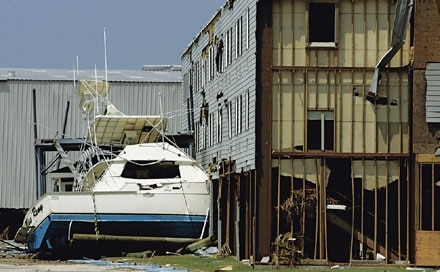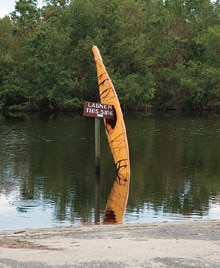
Venice, Lousiana, suffered signaficant damage from Hurrican Katrina.
Photo: Lynne Sladky
In the days after Hurricane Katrina, the destruction seemed endless. Now with recovery and rebuilding underway, some assessments of the impact on Gulf fisheries has surfaced. But just how much was lost and whether these recreational fisheries can return to what they once were remains to be seen. The following is the status, at press time, of four Gulf regions.
Louisiana
The winds and tides of Hurricane Katrina had barely left south Louisiana when officials knew the toll on the Mississippi Delta fisheries was severe. Legendary ports such as Empire, Buras, Venice, Delacroix Isle, Shell Beach, Reggio, Hopedale and Port Sulphur no longer existed. But there was also concern about the loss of coastal marshes.
The reason is painfully simple: While the raw material to rebuild homes, buildings and roads is widely available, the same cannot be said for the natural resources that sustain much of the Gulf’s rich fisheries.
Louisiana’s coastal wetlands, especially those marshes in the eastern half of the state, are the engines that power one of the nation’s most productive estuaries. They are not only the critical nursery grounds for fisheries that allow Louisiana anglers to catch some nine million speckled trout and two million redfish in a good season, they are also a key component to myriad Gulf-wide catches from Florida to Texas. Researchers estimate that 85 percent of fish caught in the Gulf depend on these estuaries. And most of them were located in Louisiana, right in the path of Katrina.
“We can’t rebuild our fisheries without those marshes. They’re important to a long list of fish,” said John Roussell, assistant secretary of the Louisiana Department of Wildlife & Fisheries. “We probably will be feeling the impact of this storm for years to come.”
— Bob Marshall
Alabama
The day after Hurricane Katrina hit the Gulf Coast, a charter boat left from Zeke’s Marina in Orange Beach with 20 fishermen. They came back with 300 pounds of fish.
“The marina has sustained some minor damage,” says Zeke’s manager, Dan Drazie. “But our fishermen are still going out everyday and catching fish.”
Sportsman’s Marina lost about half of its dock, but overall Orange Beach dodged a bullet compared to the marinas around nearby Gulf Shores and Dauphin Island. Early reports indicate that most of the artificial reefs are still in place and holding fish except for a few private reefs that were lost. Despite the damage some of the state’s fisheries withstood, several area charter captains remain optimistic about their recovery.
— John E. Phillips
Florida

| |This storm-tossed kayak wound up in Everglades National Park. Photo: Bob Stearns| Katrina’s impact was only temporary in the middle Florida Keys, although there was significant wind and water damage to boats in the Key West area, particularly around Dry Tortugas National Park. The park is closed until further notice. No reports have indicated that any charterboat services were permanently displaced, but the long-term effect of skyrocketing gasoline and diesel costs is yet to be determined.
Farther up the Florida coast, marinas are still recovering from the effects of Hurricane Dennis and the related unexpected storm surge in the Big Bend area from St. Marks to Apalachicola. Many public boat ramps still need repairs, although most are usable.
— Dave Lear
Everglades National Park
I visited Flamingo, Florida, a week after Hurricane Katrina passed just northwest of Everglades National Park. The storm took a serious toll along the shoreline from Flamingo to Cape Sable and northward to the Shark River. Many navigation markers were damaged, and there were reports of sunken boats in Florida Bay as well as other submerged debris along the coast and inside Whitewater Bay.
Access to Flamingo in Everglades National Park via the main park road was restored and reopened on September 11. The park is accessible through the main entrance daily from 5 a.m. to 7 p.m. The boat ramps and their attendant piers in Flamingo were not damaged. Other ramps were expected to reopen when conditions were safe. No infrastructure or fuel will be available until those facilities are rebuilt. There was no storm damage at the northern end of the Everglades at Chokoloskee where facilities remained open. Florida fishing guide Captain Bill Lindsay said that as of a week after Hurricane Katrina, inshore waters were dirty and fishing was very slow, but that has since improved.
— Bob Stearns









